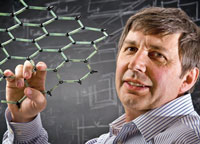| Oct 15, 2013 | |
Andre Geim: graphene is only the beginning |
|
| (Nanowerk News) Andre Konstantin Geim is the only person who ever received both a Nobel and an Ig Nobel. He was born in 1958 in Russia, and is a Dutch-British physicist with German, Polish, Jewish and Ukrainian roots. “Having lived and worked in several European countries, I consider myself European. I don't believe that any further taxonomy is necessary,” he says. He is now a physics professor at the University of Manchester. He also is attached as professor by special appointment in innovative materials and nanoscience at the Radboud University Nijmegen in the Netherlands. | |
 Andre Geim He shared the Noble Prize in 2010 with Konstantin Novoselov for their work on graphene. It was following on their isolation of microscope visible grapheme flakes that the worldwide research towards practical applications of graphene took off. “We did not invent graphene,” Geim says, “we only saw what was laid up for five hundred year under our noses.” Geim and Novoselov are often thought to have succeeded in separating graphene from graphite by peeling it off with ordinary duct tape until there only remained a layer. Graphene could then be observed with a microscope, because of the partial transparency of the material. That is, after dissolving the duct tape material in acetone, of course. That is also the story Geim himself likes to tell. However, he did not use – as the urban myth goes – graphite from a common pencil. Instead, he used a carbon sample of extreme purity, specially imported. He also used ultrasound techniques. But, probably the urban legend will survive, as did Archimedes' bath and Newtons apple. “It is nice to keep some of the magic,” is the expression Geim often uses when he does not want a nice story to be drowned in hard facts or when he wants to remain discrete about still incomplete, but promising research results. Because of its chemical structure, graphene is an excellent conductor: carbon has a valence of four, but in the graphene structure only three electrons are bound, the fourth is free. Potential short to medium term practical applications range from new generation solar cells to biosensors as well as new generation computer chips, unbreakable space crafts and feather weight bullet proof jackets. |
|
| Geim expects practical applications of these materials will appear soon after the research results are published. “In the past, it took forty years before new discoveries lead tot consumption market products. For graphene applications, only ten years passed.” | |
| Geim is already looking in a more distant future. He thinks that probably, much more materials exist, that in structures with only one layer of atoms have surprising properties. “I don't believe this is only the case for carbon varieties, but also for other elements of the periodic system and even for complex molecules. I suggest we should look again at mica,” Geim tells youris.com. His more recent research involves graphene-based membranes. For some time, he is not convinced anymore that graphene membranes exceed very much the prestations of existing membranes in for instance desalination of water. However, he wants to find out what causes that water is able to pass graphene membranes, while it is impossible for other liquids. | |
| Geim underlines the importance of thinking 'out of the box' and 'trial and error' experiments. This approach is not only a reference to his mechanical graphene peeling, but also to his Ig Nobel work. The Ig Nobel Prizes are given for unusual or trivial scientific research achievements making people laugh, before they make them think. Geim won this prize together with Mike Berry, for the levitation of a little frog in a strong magnetic field. "First we used a hamster. After we saw the hamster didn't like it, we took a frog." Whether the frog liked the experiment, Geim does not know. The hamster, dubbed H.A.M.S. ter Tisha, was rewarded with a co-authorship of the research paper. The frog still remains anonymous. |
| Source: By Koen Mortelmans, Youris |
